The second of two days of tours today, based in North Norfolk. The North Wind was blowing, and blowing hard, bringing with it some squally and at times wintry showers. Not all the group felt up to braving the weather today, after such a successful day yesterday, but those that did enjoyed some more exciting birds.
With the rain supposed to ease off early morning, we headed to Titchwell first where we could get some shelter in the hides. There were a good number of Blackbirds and a Song Thrush along the entrance track, presumably some being more birds which had arrived from the continent yesterday or overnight (like the ones we had seen coming in at Cley yesterday). It was breezy in the car park, which was quieter than usual, but there was some shelter here for the birds. A tit flock was feeding in the corner – Long-tailed Tits, Blue Tits and Coal Tits and a couple of Goldcrests with them.
Despite the conditions, we had a look in the overflow car park. There were not so many birds in here today, just a few Chaffinches and Greenfinches feeding on the brambles. However, it was worth the quick circuit we gave it as a pair of Bullfinches flew up from the brambles calling. Even better, rather than flying off, they perched for a while, the male flying down repeatedly into the brambles to feed on the remaining blackberries.
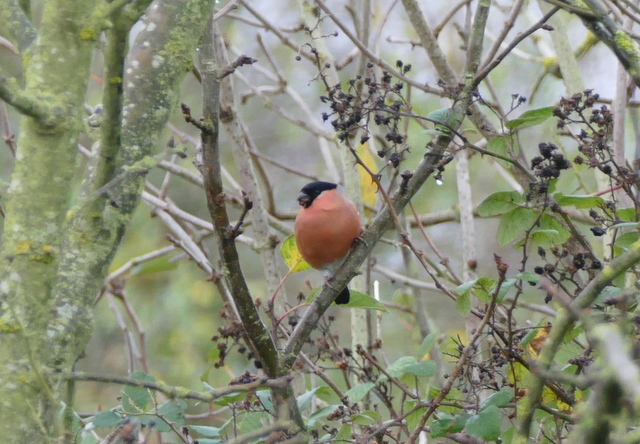 Bullfinch – a pair were in the car park feeding on blackberries
Bullfinch – a pair were in the car park feeding on blackberries
By the path through the trees to the visitor centre, we caught up with the tit flock again. They were feeding low down in the bushes, and a Coal Tit in front of us was suddenly joined by a Marsh Tit. It dropped right down into the litter below and started to feed among the leaves. The feeders by the visitor centre were rather quiet today (apart from a Grey Squirrel and a Brown Rat), so we made our way out onto the reserve.
It was properly windy out on the main path, and spitting with rain, so we got our heads down and made straight for Island Hide. The first thing we saw when we got there was two swans out on the water. A quick look through the scope confirmed they were Whooper Swans, with lots of yellow on the bill extending down to a point. There are lots of swans on the move at the moment – both Whoopers and Bewick’s – coming in for the winter as it starts to get colder in northern Europe. These two Whooper Swans had probably stopped off for a rest and some respite from the wind on their journey.
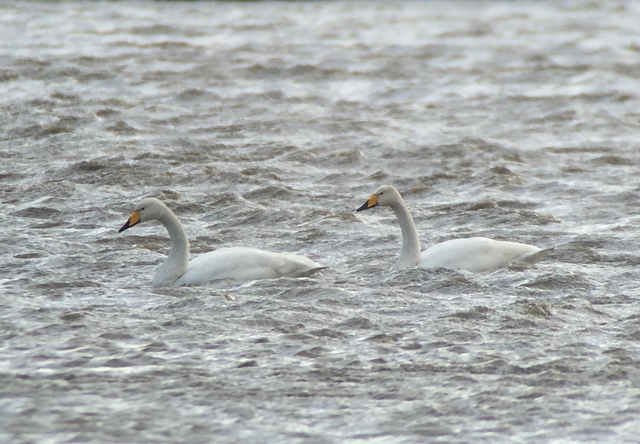 Whooper Swans – these two had sought refuge on the freshmarsh
Whooper Swans – these two had sought refuge on the freshmarsh
The water levels on the freshmarsh are being raised at the moment for the winter, but there are still some islands left exposed. These were packed with ducks and waders. The wildfowl were well represented, with lots of Wigeon, Teal, Mallard and Gadwall and a few Shoveler.
There were several little groups of Dunlin and in with them we could see a few Turnstone and Ringed Plovers. The latter two were probably taking shelter on here from the beach. A few hardy Avocets are hanging on here too – some were huddled down against the wind, but others were trying to feed up to their bellies in the rising water. The Black-tailed Godwits were mostly trying to sleep on the islands.
A squally shower passed over, moving quickly on the strong wind, and when it brightened up afterwards we made a quick dash for Parrinder Hide. Two Common Snipe on the island in front of the hide were a nice addition to the day’s list – always smart birds to see. A single Knot dropped in briefly with the Dunlin, but was spooked by some ducks and flew off again.
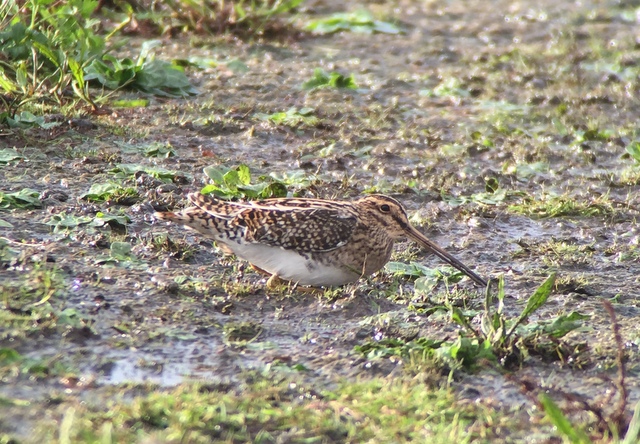 Common Snipe – two were on the island in front of Parrinder Hide
Common Snipe – two were on the island in front of Parrinder Hide
However, the highlight from here was a Water Pipit which worked its way along the edge of the water, at the bottom of the bank beyond the hide. When we first picked it up, it was some way back, but it came steadily closer, working its way carefully all round the dead weedy growth, picking in amongst it for food. We could see its pale off white underparts with neat black streaks and pale supercilium. The Water Pipit got almost down to the hide when it decided that was close enough and flew off past us calling.
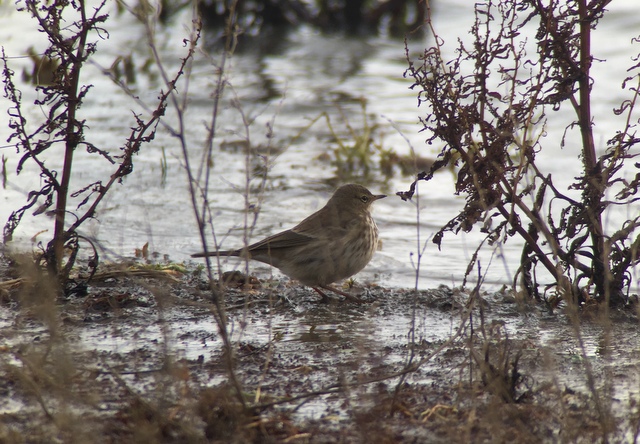 Water Pipit – on the edge of the freshmarsh by Parrinder Hide
Water Pipit – on the edge of the freshmarsh by Parrinder Hide
Despite the wind, the Marsh Harriers made an appearance over the reedbed, two pale-headed, chocolate brown young birds enjoying the wind. Then we made our way over to the other side of Parrinder Hide to have a look at the Volunteer Marsh.
It was hard on this side – the windows were wet and it was too windy to open them! Through the glass, we did manage to see a few more waders. Several Grey Plovers were seemingly unperturbed by the weather and were walking about on the mud as usual, as were a few Redshank. The Knot had sought shelter in the islands of vegetation, where we could see them occasionally as they moved through feeding. Two Curlews had gone to sleep in the lee of the reeds.
It was while we were in here that we spotted some dark shapes up over the beach further over and through the scope we could see they were at least six Great Skuas. It was not raining at this stage, so we thought we might brave the walk out towards the beach and try our luck with a bit of seawatching. A few Little Auks had been reported flying past and this was a bird we really wanted to see.
We got half way there and were beaten back a short way to the Volunteer Marsh by another brief shower which came through, but then carried on undaunted. We got to the dunes and tucked ourselves down on the inland side, where we were surprisingly sheltered from the worst of the wind. From here, we scanned the sea, which was getting rather rough with some impressive breakers!
 Titchwell Beach – the sea was rather rough today!
Titchwell Beach – the sea was rather rough today!
There was a big movement of skuas along the coast today, mostly Great Skuas. The ones we had seen from Parrinder Hide had moved on and at first there seemed to be no more coming through. We had to content ourselves with watching the big flocks of Kittiwakes which had been forced inshore, some coming right along the beach in front of us. There were little flocks of ducks moving past offshore. A Goldeneye flew past over the sand and a couple of Scaup went through a little further out over the breakers. Several flocks of Dunlin came past along the shore, buffeted in all directions by the gusting wind. The Sanderling were still toughing it out on the beach, running in and out of the foam.
We picked up three more rather distant Great Skuas making their way towards us from the direction of Scolt Head and, while we were waiting for them, we spotted three much smaller birds come skimming over the beach. Black above, white below, they came right towards us and straight past along the edge of the waves – three Little Auks, just the bird we had really been hoping to see.
Little Auks are only about the size of Starlings and two thirds the size of a Puffin. They nest on islands in the high Arctic and spend the winter at sea. They are very vulnerable to predation and rarely come inshore. Only after northerly storms in late autumn do you stand a good chance of seeing them further south, so this was the perfect day to see them.
While we had been watching the Little Auks, we lost sight of the three Great Skuas coming our way. However, more skuas then started to come through as some more squalls blew in and we ended up seeing a couple of good size flocks of Great Skuas pass through. We didn’t spend too long out at the sea today and, with our main target achieved, we beat a retreat back towards the visitor centre.
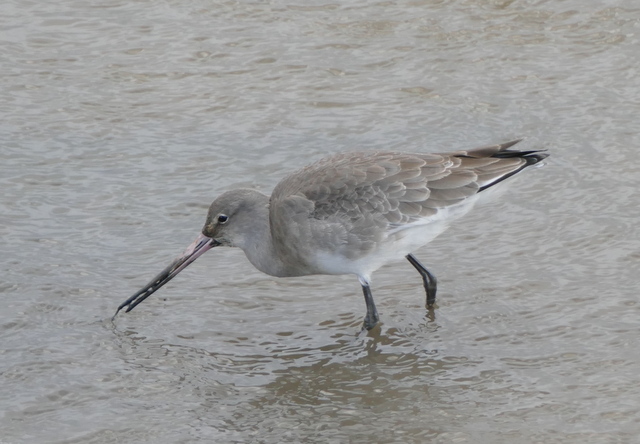 Black-tailed Godwit – feeding by the main path on the way back
Black-tailed Godwit – feeding by the main path on the way back
Scanning from the path on the way back, we picked up a Greenshank sheltering at the back of the Tidal Pools. A very obliging Black-tailed Godwit was feeding right on the nearest edge of the Volunteer Marsh. We had planned to get back to the Visitor Centre for a hot drink to warm us up after our vigil, but when we got there we found it all closed up with the lights off. Very unusual. Then the door opened and we were told why – a power cut.
During lunch, we heard of a Little Auk which had been blown in onto some pools at Salthouse, so we started to make our way east to try to see it. Unfortunately, on our way there, we heard that it had been taken into care, so that plan was hastily aborted. We stopped at Holkham instead for a rethink. There were several groups of Pink-footed Geese still along Lady Anne’s Drive. Down at the far end, three Grey Partridge were feeding on the edge of the field.
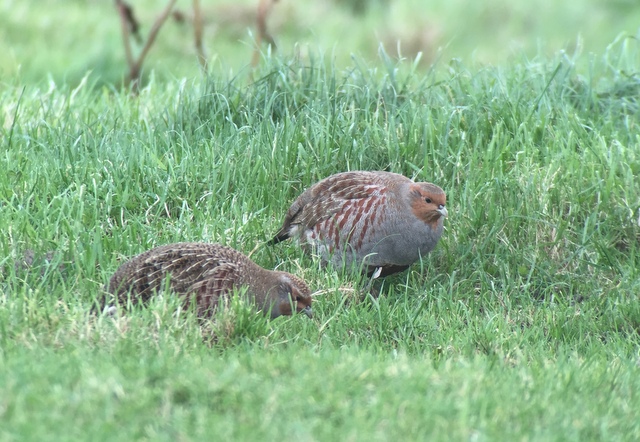 Grey Partridge – 2 of the 3 by Lady Anne’s Drive, a pair
Grey Partridge – 2 of the 3 by Lady Anne’s Drive, a pair
With a new member of the group having joined us today and keen to see a Firecrest, we nipped quickly along the path towards Salts Hole. In the bushes by the path just before we got there, we could hear Goldcrests calling and stopped to take a closer look. Suddenly a Firecrest dropped in as well – we could see its striking head pattern, with white supercilium and black eye stripe. It didn’t hang around long, just long enough for us to get a look at it, before darting across the path and into the trees.
We had planned all along to try to visit the harrier roost today. It was not the best weather for it, for us at least, but the harriers have to come in whatever the conditions. It seemed to have brightened up a bit and stopped raining, and it might have been wishful thinking but the wind seemed to have eased a little as well, so we decided to give it a go.
Walking along the track, there were lots of Blackbirds in the hedges either side, which flushed ahead of us as we walked. We could hear Redwing calling and one flew down the path ahead of us. A Fieldfare darted across in front of us, flashing its grey rump, and disappeared into the hedge the other side. The hawthorns here are laden with berries and presumably these birds were all trying to feed up after the long journey across the North Sea. Down at the bottom, something flushed from the bottom of the hedge by the path in a flurry of wings and crashed into the branches in a tangle, struggling to break through at first. A Woodcock, also probably fresh in from the continent, it finally escaped and flew up and back across the path.
It was very exposed on the edge of the saltmarsh, looking straight into the wind. At first it seemed bearable. A Merlin flashed across and into a flock of Starlings feeding on the ground, causing mass panic. A ringtail Hen Harrier was quartering the far edge of the saltmarsh right over towards East Hills and a second ringtail Hen Harrier flew up to join it, the two of them interacting for a few seconds before flying off. A little later, one of them flew back towards us along the edge of the saltmarsh, giving us a better view. Then the wind picked up again as some more wintry showers came in from the North Sea towards us. A straw poll voted for a hasty retreat, and we were walking back and in the shelter of the hedges again when a squally hail shower came over. We decided to call it a day.
It had been a successful day. Once again, despite the worst that the weather could throw at us, we had been out… and seen some very good birds!
















